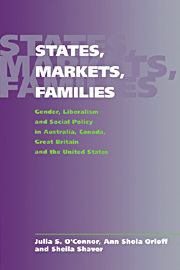 States, Markets, Families
States, Markets, Families Book contents
- Frontmatter
- Contents
- List of Tables
- Acknowledgements
- 1 Gendering Theories and Comparisons of Welfare States
- 2 Liberalism, Gender and Social Policy
- 3 The Labour Market and Social Policy
- 4 Social Rights Versus Gender Stratification and Gender Power?
- 5 Body Rights, Social Rights and Reproductive Choice
- 6 Liberalism, Gendered Policy Logics and Mobilisation
- 7 States, Markets, Families
- References
- Index
7 - States, Markets, Families
Published online by Cambridge University Press: 27 October 2009
- Frontmatter
- Contents
- List of Tables
- Acknowledgements
- 1 Gendering Theories and Comparisons of Welfare States
- 2 Liberalism, Gender and Social Policy
- 3 The Labour Market and Social Policy
- 4 Social Rights Versus Gender Stratification and Gender Power?
- 5 Body Rights, Social Rights and Reproductive Choice
- 6 Liberalism, Gendered Policy Logics and Mobilisation
- 7 States, Markets, Families
- References
- Index
Summary
The defining characteristic of the liberal social policy regime is state intervention which is clearly subordinate to the market and the family. But, to a significant extent, liberal policy works through the market, as in the case of tax credits for the purchase of services such as child care, and regulation of the market, for example through anti-discrimination legislation or the setting of minimum standards for market-based services such as child care. It has a relatively strong emphasis on income and/or means-tested programs and while there may be a commitment to universalism, it is universalism with an equal opportunity focus. The implications of these arrangements for families and households and for gender relations have received little attention in comparative welfare state analysis. There are significant cross-national differences in the balance between market and family in providing benefits and services for individuals and households, and, specifically, there are significant differences in terms of gender and class consequences depending on which of the two forms of private responsibility, market or family, is supported by public policy.
Does a liberal political tradition have a congruous set of consequences for gender relations across the three policy areas of income maintenance, labour market participation and reproductive rights in Australia, Canada, the United States and Britain? The concept of policy regime refers to institutionalised patterns of welfare state provision establishing systematic relations between the state, the market and the family. Our analysis of policies relating to labour markets, income maintenance and regulation of reproduction in Australia, Canada, Britain and the United States identified significant similarities in policy orientation but also some noteworthy differences across the four countries.
- Type
- Chapter
- Information
- States, Markets, FamiliesGender, Liberalism and Social Policy in Australia, Canada, Great Britain and the United States, pp. 223 - 237Publisher: Cambridge University PressPrint publication year: 1999


